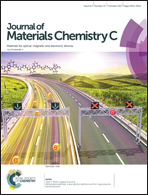Probing lattice vibration and strain states in highly phosphorus-doped epitaxial Si films†
Abstract
We investigated the lattice vibration and strain states in highly P-doped epitaxial Si films using Raman scattering and X-ray diffraction (XRD) measurements. Raman analyses using a visible (VIS) ray do not show any dependence on P doping, which is not consistent with previous XRD studies. This inconsistency can be fully understood in terms of the optical penetration depth elucidated using spectroscopic ellipsometry. In Raman spectra with an excitation source in ultraviolet (UV) regions, Si–P like vibration modes are observed for the first time as a proof of the incorporation of P. Furthermore, the contribution of strain and composition to the phonon shift of the first-order Si–Si vibration mode is decoupled from the experimental values and theoretical calculations. As the post-annealing temperature increases, the intensity ratios of Si–P like and Si–Si vibration modes decrease and the Si–Si peak positions shift to a higher frequency, thus indicating that P diffusion occurs at a temperature over 850 °C, which is supported by the secondary ion mass spectrometry (SIMS) and XRD results. Our systematic study will give more insights into evaluating the atomic bonding, composition and strain states of the as-grown and annealed P-doped Si thin films.



 Please wait while we load your content...
Please wait while we load your content...